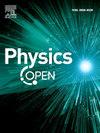Klein-Gordon方程和机器学习增强的功能分析:通过分析和预测建模方法洞察双原子分子系统
IF 1.4
Q2 Physics and Astronomy
引用次数: 0
摘要
本研究利用Nikiforov-Uvarov泛函分析方法,结合Hellmann势和修正的Kratzer势,采用离心项的green - aldrich近似,解析求解Klein-Gordon方程,研究了标量势和矢量势影响下无自旋粒子的行为。利用解析能量特征值和特征函数研究了特定双原子分子(CO、NO、N2和CH)的能谱,证明了这些性质与势参数和量子数的相关性。除了分析结果外,还使用随机森林和神经网络回归等机器学习技术根据计算数据对能谱进行建模和预测。这使得快速探索能源景观成为可能。ML模型与分析结果非常一致,并且在推断新的量子数和分子类型方面做得更好。这种混合分析- ml方法是加快双原子分子系统研究的有力途径。它结合了量子力学的严谨性和数据驱动的预测,使得在理论和计算化学中有效地筛选分子能谱成为可能。本文章由计算机程序翻译,如有差异,请以英文原文为准。
Klein-Gordon equation and machine learning-enhanced functional analysis: Insights into diatomic molecular systems via analytical and predictive modeling approaches
This study investigates the behavior of spinless particles under the influence of scalar and vector potentials by analytically solving the Klein-Gordon equation using the Nikiforov-Uvarov functional analysis method, coupled with the Hellmann and modified Kratzer potentials, employing the Greene-Aldrich approximation for the centrifugal term. The analytical energy eigenvalues and eigenfunctions were utilised to examine the energy spectra of specific diatomic molecules (CO, NO, N2, and CH), demonstrating the correlation of these properties with potential parameters and quantum numbers. In addition to the analytical results, machine learning techniques like Random Forest and Neural Network regressors were used to model and predict the energy spectra based on the calculated data. This made it possible to swiftly explore energy landscapes. The ML models showed great agreement with the analytical results and were better at extrapolating to new quantum numbers and molecular types. This hybrid analytical-ML approach is a strong way to speed up the study of diatomic molecular systems. It combines the rigour of quantum mechanics with data-driven predictions and makes it possible to efficiently screen molecular energy spectra in theoretical and computational chemistry.
求助全文
通过发布文献求助,成功后即可免费获取论文全文。
去求助
来源期刊

Physics Open
Physics and Astronomy-Physics and Astronomy (all)
CiteScore
3.20
自引率
0.00%
发文量
19
审稿时长
9 weeks
 求助内容:
求助内容: 应助结果提醒方式:
应助结果提醒方式:


